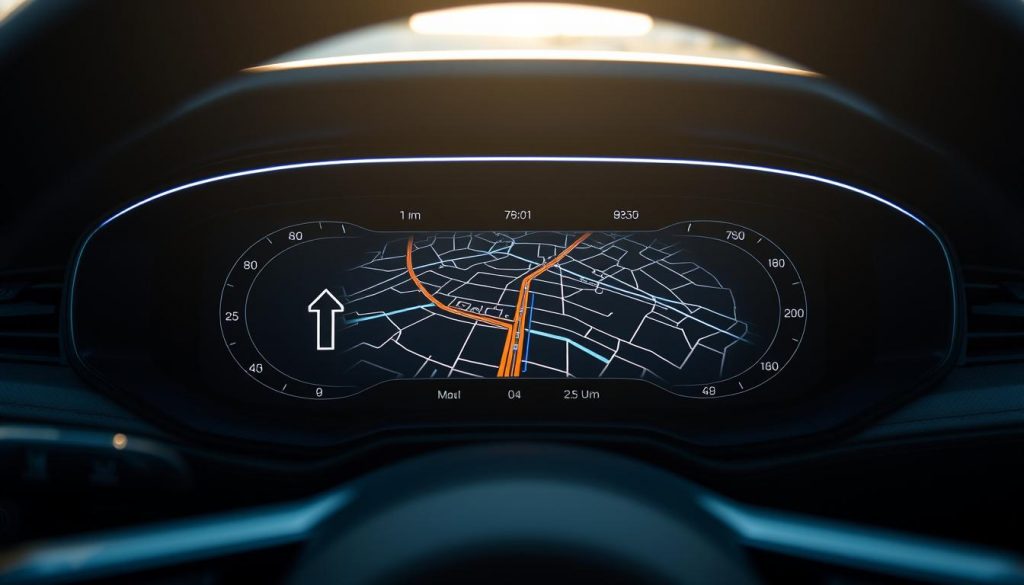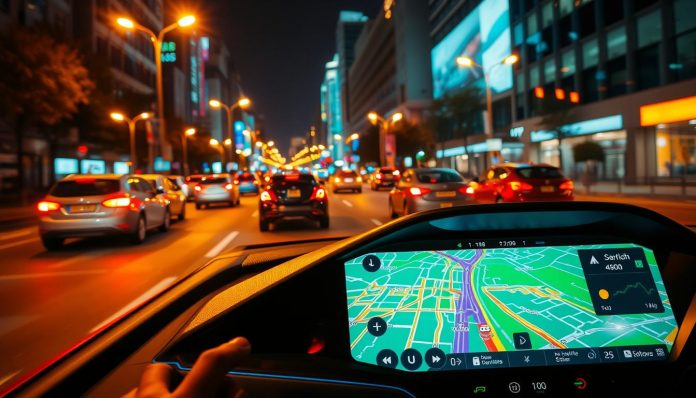Have you ever found yourself in the wrong lane at a complex junction, desperately trying to merge while other drivers honk? This frustrating experience might soon become a thing of the past.
A significant update is arriving for certain vehicles. This innovation uses advanced technology to automatically detect a car’s position on the road. It then offers customised, real-time navigation help with clear audio and visual prompts.
The goal is to simplify driving in complicated situations. It represents a major leap forward in driving assistance, aiming to make journeys smoother and less stressful for motorists.
The Polestar 4 will be the first car to receive this exciting new functionality. It’s designed to tackle common navigation challenges head-on, providing drivers with timely information.
Key Takeaways
- This new feature provides real-time assistance for lane positioning.
- It uses sophisticated technology to automatically detect a vehicle’s placement.
- Drivers receive customised guidance through clear audio and visual cues.
- The update aims to simplify navigation on complex roads and at busy junctions.
- The Polestar 4 is the first vehicle set to benefit from this advancement.
- It represents a substantial improvement in modern driving assistance systems.
- The overall goal is to create a less stressful and more confident driving experience.
How Google Maps’ AI-Driven Live Lane Guidance Works
Modern vehicles are gaining remarkable capabilities to understand their surroundings. This sophisticated feature represents a significant step forward in driving assistance technology.
The system relies on the car’s front-facing camera to continuously monitor the road ahead. It captures detailed visual information about lane markings and traffic signs.
Never miss a turn again; read how AI-powered Live Lane Guidance upgrades Google Maps
Camera-Based Detection Technology
The camera acts as the system’s eyes, scanning the road surface for clear markings. It identifies various lane types and reads important road signs in real-time.
This visual data forms the foundation for the navigation assistance. The camera’s high-resolution capabilities ensure accurate detection even in challenging conditions.
Real-Time Processing and Analysis
Advanced software processes the camera’s input instantly. It analyses the vehicle’s position relative to lane markings and upcoming road layouts.
The system combines this visual information with existing navigation data. This creates a comprehensive understanding of the current driving situation.
When the software detects potential lane positioning issues, it provides timely guidance. Drivers receive clear visual prompts on their instrument display.
The integration between hardware and software components ensures seamless operation. This sophisticated combination delivers reliable assistance during complex driving scenarios.
Multiple lane situations and intricate road layouts are handled with precision. The technology adapts to various driving environments across different regions.
This represents a substantial advancement in how vehicles interpret and respond to road conditions. It provides motorists with enhanced confidence during their journeys.
Why This Navigation Advancement Matters for Drivers
Urban driving presents unique challenges where traditional satellite navigation often struggles. Tall buildings can interfere with signals, making precise positioning difficult when it matters most.

This innovative feature significantly enhances driving safety. It provides continuous support through complicated motorway systems and busy intersections.
Motorists experience reduced stress when approaching multi-lane junctions. The system offers timely advice for lane selection, preventing last-minute manoeuvres.
The technology proves particularly valuable on sprawling motorways with parallel lanes. It helps drivers maintain correct positioning for their intended exit or interchange.
Key benefits include:
- Improved confidence in unfamiliar cities or complex road networks
- Reduced likelihood of missing important exits or on-ramps
- Enhanced accuracy beyond standard GPS in urban canyons
- Clear audio and visual prompts for maintaining correct lane positioning
The system does have certain limitations. It performs best in areas with clear lane markings and may have reduced effectiveness during severe weather conditions.
This advancement represents the future of intelligent driving assistance. It demonstrates how technology can adapt to real-world driving challenges rather than relying solely on satellite data.
Motorists can expect more confident navigation through areas like Manchester’s ring roads or London’s complex motorway interchanges. The technology understands that sometimes the correct lane choice needs to happen well before the junction itself.
See how Google Maps Gets Powerful Navigation Upgrade with Gemini.
Google Maps: AI Powers Better Live Lane Guidance
Current Implementation: Polestar 4 Leads the Way
The journey towards smarter motoring takes a significant leap with its first real-world application. Polestar’s latest model stands at the forefront of this technological advancement.
This sophisticated system integrates directly with the car’s built-in infotainment. It represents a seamless fusion of hardware and intelligent software.

Vehicle Integration and Display Features
Polestar 4 vehicles showcase this innovation through their advanced digital cockpit. The 10.2-inch driver display presents clear visual prompts for lane positioning.
Drivers receive intuitive guidance directly within their instrument cluster. The system uses colour-coded indicators and directional arrows.
This integration ensures motorists keep their eyes on the road while receiving crucial navigation information. The feature works harmoniously with the existing Google Built-in platform.
Geographical Rollout and Future Expansion
Initial availability begins in the United States and Sweden within the coming months. The technology will first activate on select major highways.
Expansion plans include support for additional road types and regions. Partnership discussions with other automakers are underway for broader implementation.
Motorists can expect wider availability across various vehicle models in future. The system’s capabilities will grow through continuous software improvements.
“This represents just the beginning of how intelligent systems will transform everyday driving experiences.”
The technology demonstrates Polestar’s commitment to cutting-edge automotive innovation. It sets a new standard for what drivers can expect from modern navigation systems.
Conclusion: Google Maps: AI Powers Better Live Lane Guidance
The Future of AI-Enhanced Driving Assistance
This innovation marks a major step in how we navigate. It shows where modern motoring technology is heading.
Drivers can expect smarter assistance systems in their vehicles. These features help make journeys safer and less stressful.
This technology could change how people use in-car navigation. Some may prefer built-in systems over other options.
Looking ahead, such advancements will likely expand to more regions and road types. They represent the exciting future of driving assistance.
For the latest updates on navigation tech, check this navigation news.


